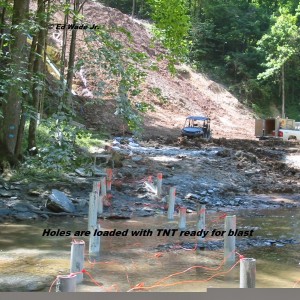“Risk Assessment Required for Proposed Pipeline Route in High Consequence Areas”
Press Release by Lauren Ragland, WV Wilderness Lovers vs. Proposed Pipeline, September 3, 2014
US Department of Transportation law mandates that all natural gas operators are required to conduct a detailed Risk Assessent [RA] for a proposed pipeline in a High Consequence Area [HCA].
The focus of the Risk Assessment will be the swiftness of leak detection and pipeline shut down capabilities and the proper equipment and response plan when there is an unexpected reduction in pressure from a pipeline rupture. “The operator must, at least, consider the swiftness of leak detection and pipeline shut down capabilities and benefits expected by reducing the spill size.”
The newly named Atlantic Coast Pipeline [ACP] (announced in May as Dominion’s South East Reliability Project or SE-Pipeline) is routed straight through a massive high consequence area [HCA].
Waterways affected include the Tygart Valley River, Shavers Fork of the Cheat, West Fork of Greenbrier, East Fork of Greenbrier, Buckhannon River, Hackers Creek, Lamberts Run, Red Run.
River headwaters affected would those of the Cherry River, Cranberry River, Elk River, Gauley River, Greenbrier River, Tygart Valley River, Williams River, and Shavers Fork of the Cheat River.
The Risk Assessment is required to have a plan for providing water to the residents downstream if there is a damaging leak. This would include communities and cities hours away. Typically the natural gas companies provide a huge backyard tank called a water buffalo that would be filled every couple of days possibly forever. Where this water would come from should be of concern to anyone reading this.
By the definition of the U.S. Department of Transportation Pipeline and Hazardous Materials Safety Administration [PHMSA], the area is deemed an HCA when the “consequences of inadvertent releases from pipelines could have the most significant adverse consequences.” The law is that:
>> “Specific areas and locals are to be identified and operators are required to devote additional focus, efforts, and analysis in HCAs to ensure the integrity of pipelines.”
>> “Releases from pipelines can adversely affect human health and safety, cause environmental degradation, and damage personal or commercial property.”
>> “The proposed pipeline route [PPR] is identified as a HCA because the identification “focuses on populated areas, drinking water sources, and unusually sensitive ecological resources.”
>> “Drinking water sources include those supplied by surface water or wells and where a secondary source of water supply is not available. The land area in which spilled hazardous liquid could affect the water supply is also treated as an HCA.’
>> “Unusually sensitive ecological areas include locations where critically imperiled species can be found, areas where multiple examples of federally listed threatened and endangered species are found, and areas where migratory waterbirds concentrate.”
>> “Critical drinking water sources and unusually sensitive ecological areas are identified using information from National Heritage Programs and Conservation Data Centers in each state, in conjunction with The Nature Conservancy.”
>> “Pipeline operators must determine which segments of their pipeline could affect HCAs in the event of a release.”
>> “Hazardous liquid pipelines that pass through an HCA, or that pass near enough that a release could reach the area by flow over land or within a river, stream, lake, or other means, are assumed to have the potential to affect that area.”
>> “Gas transmission pipelines that pass within any of the HCA potential impact circles are assumed to have the potential to affect that area.”
Thus – we demand a complete risk assessment as required by federal law now, which is common sense.
SOURCE: “Fact Sheet: High Consequence Areas” Revised: 12/01/2011 at: www.primis.phmsa.dot.gov/comm/FactSheets/FSHCA.htm
>>> Lauren Ragland and Ed Wade are the founders of “WV Wilderness Lovers vs Proposed Pipeline,” who thank Professor Diane Gooding and Elisabeth Radow, Attorney at Law, for their assistance. Photo of Dynamiting Stream in Wetzel County WV by Ed Wade Jr. ©

